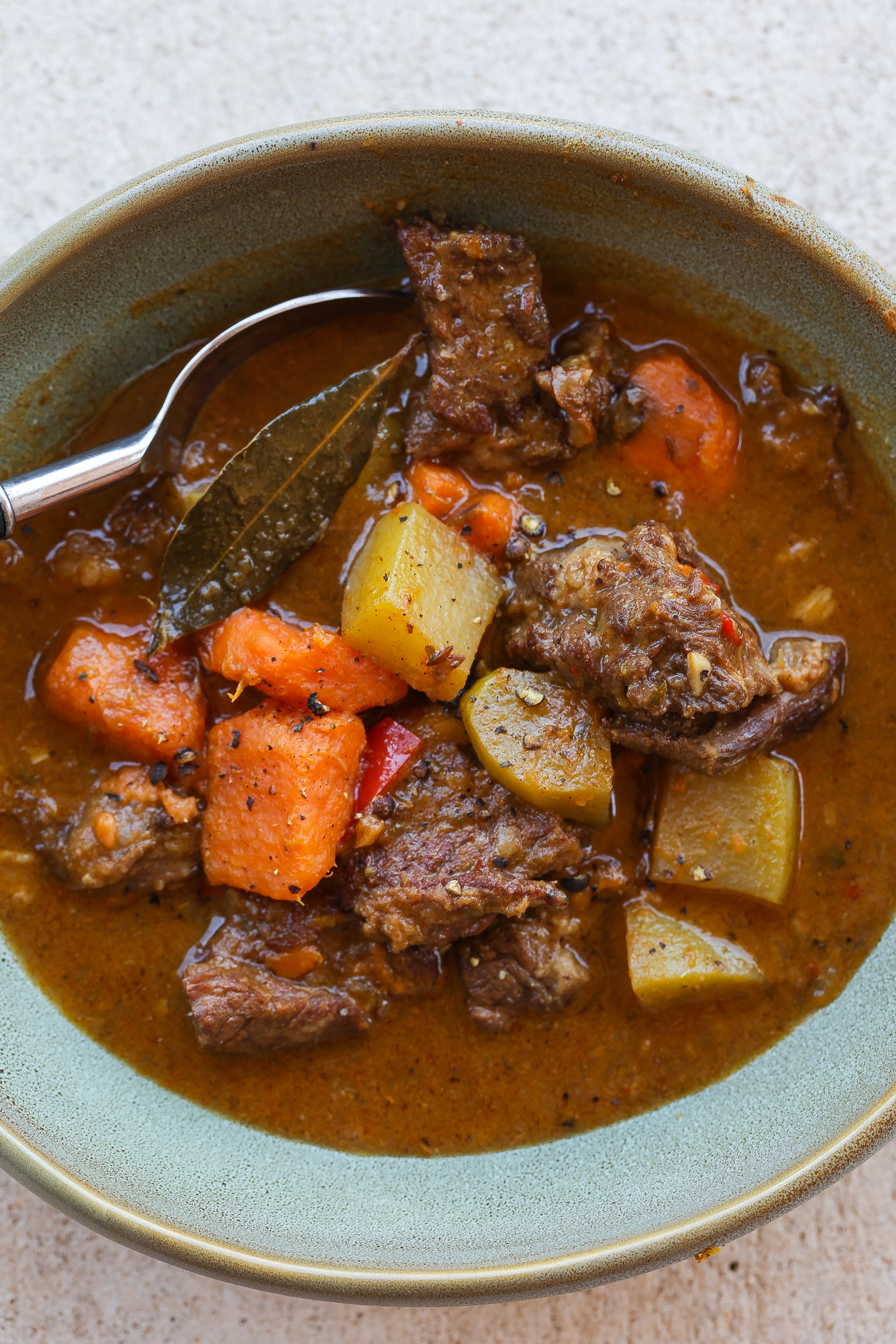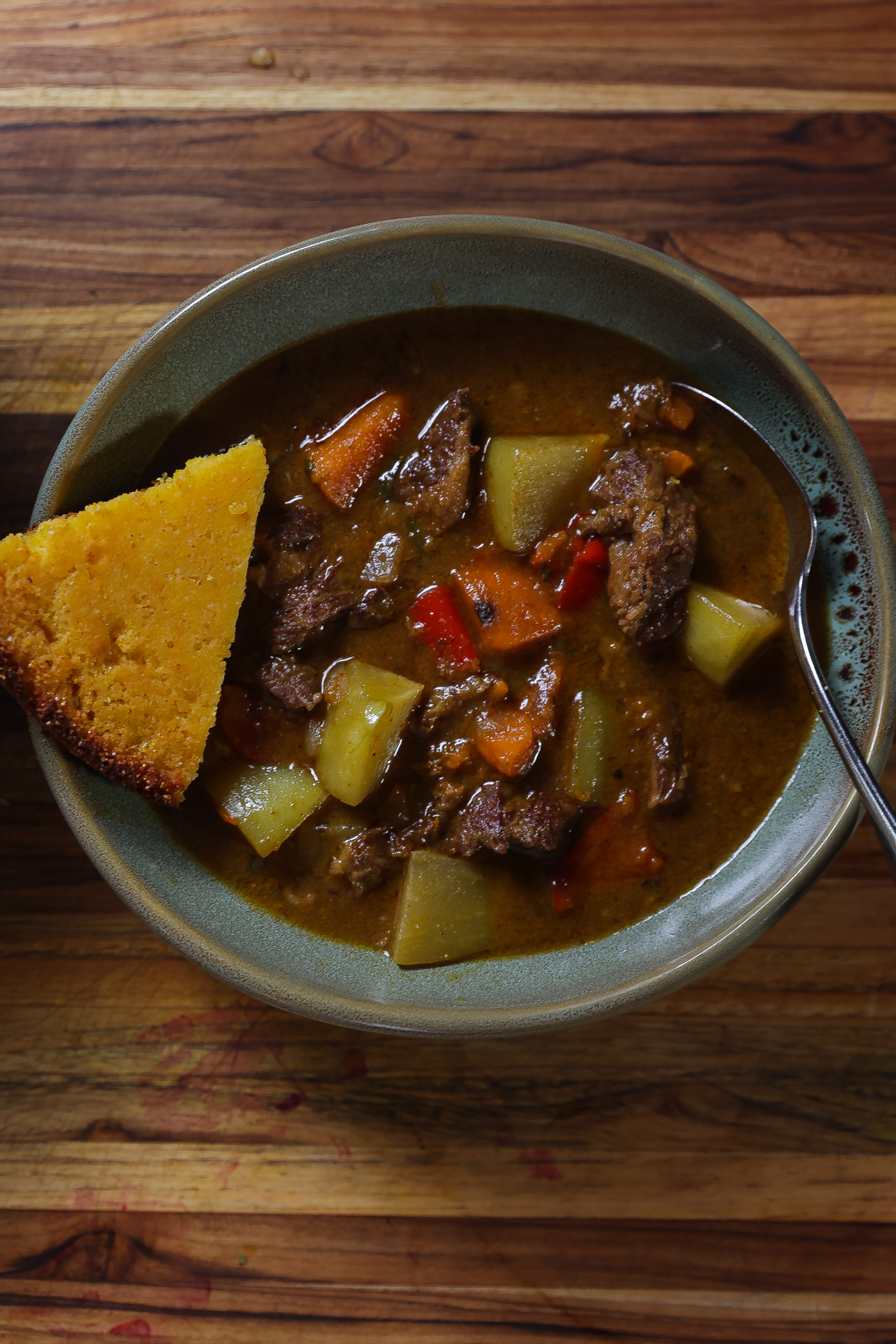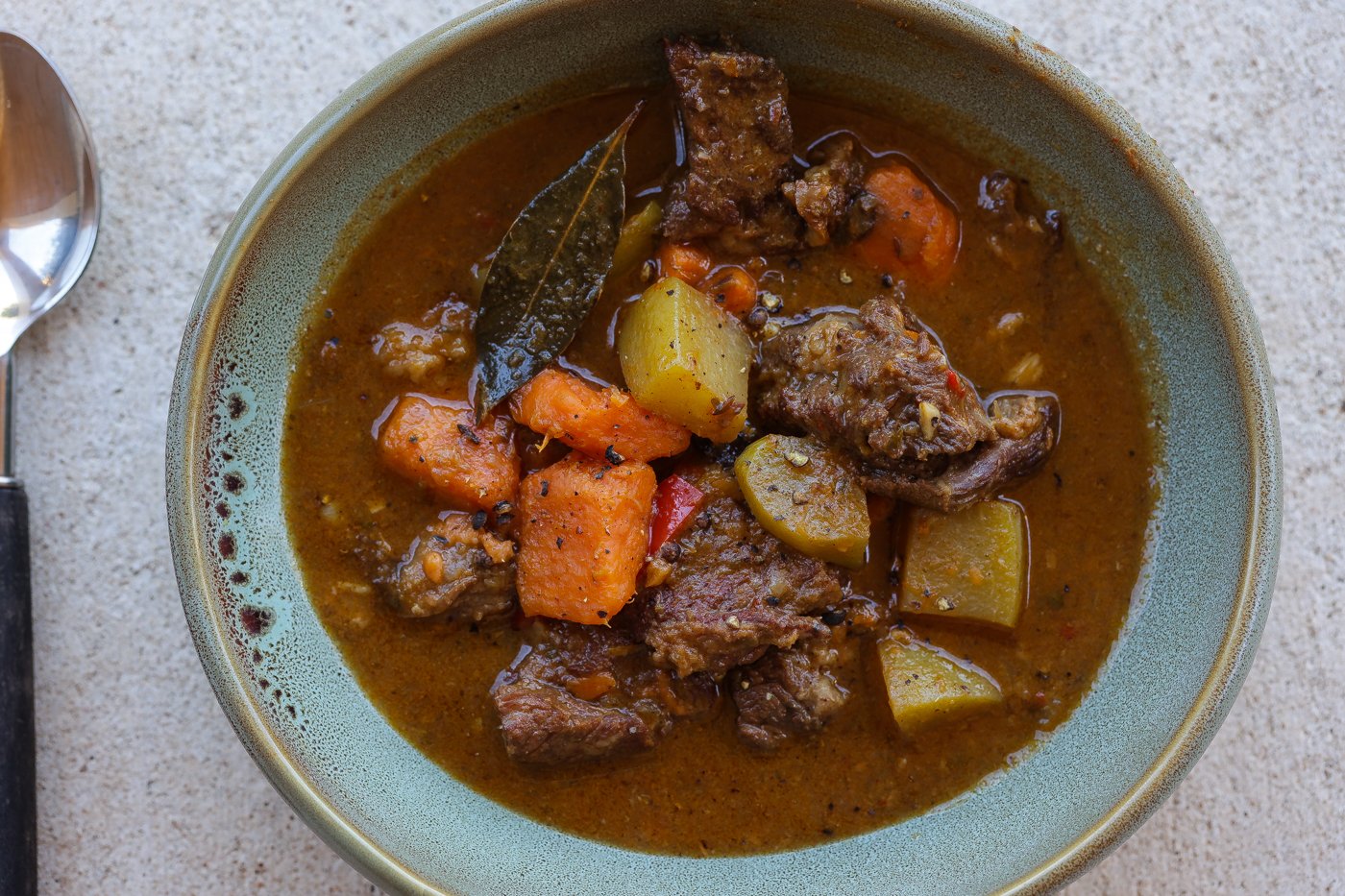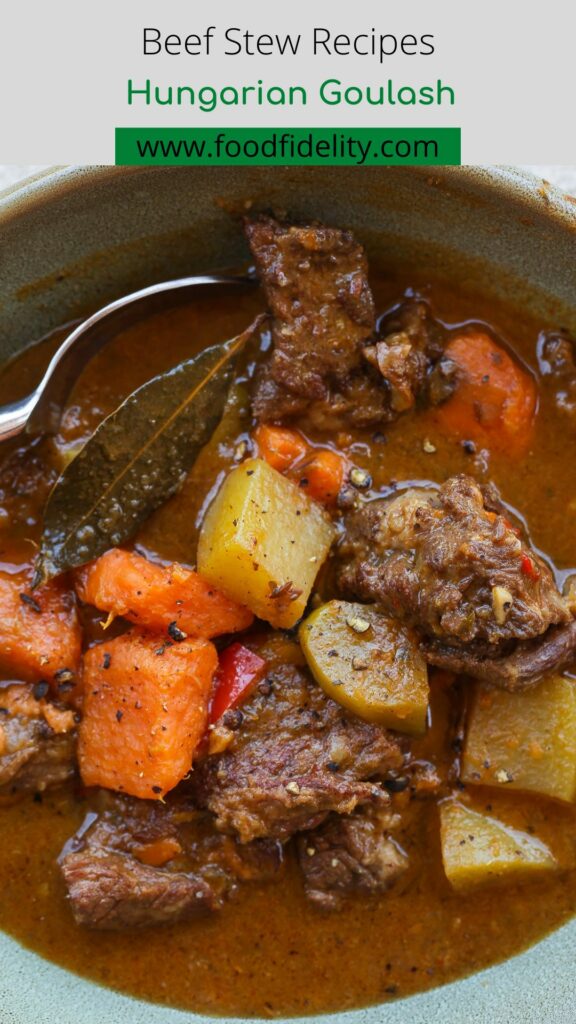My fellow flavor-philes join me as I embark on a culinary journey that fuses the rich flavors of Hungarian tradition with the vibrant essence of Caribbean cuisine in this unique and delectable dish. Our Hungarian Goulash, renowned for its hearty and robust taste, takes a delightful twist as it is expertly seasoned with the bold and aromatic Haitian epis—a flavorful blend of herbs and spices.
The infusion of these diverse culinary influences creates a surprising and harmonious mix of tastes that tantalize the palate. But that's not all—this fusion masterpiece goes a step further by introducing the subtle sweetness of sweet potatoes and the crisp, mild flavor of chayote, transforming the classic goulash into a sensational and globally inspired delight.
Get ready to savor each spoonful as this dish transcends boundaries, offering a culinary experience that transcends borders and celebrates the diverse beauty of global flavors.
Related Beef Recipes:
Step into the groovy kitchen where tradition meets a Caribbean breeze in this electrifying authentic Hungarian Goulash recipe with a soulful twist. Picture the rhythmic simmer of tender beef, harmonizing with the lively dance of island-inspired spices.

What Is Goulash
It may be worth it to start by explaining what ain't goulash. Growing up what we called goulash was really a pasta and ground beef dish which was closer to hamburger helper than it was to beef stew.
Goulash is a hearty and flavorful stew that originated in Hungary (it's national dish level!), but it has become popular in various Central European and Eastern European cuisines. The dish typically features chunks of beef (though other meats like pork or lamb can be used), cooked with an assortment of vegetables such as potatoes, onions, bell peppers, and tomatoes.
It is known for its rich and savory flavor, which comes from a combination of paprika, caraway seeds, and other spices. It is often slow-cooked to allow the flavors to meld, resulting in a comforting and robust stew.
Goulash is traditionally served over egg noodles, rice, or potatoes, making it a satisfying meal. The versatility and warm, spiced profile of goulash have contributed to its popularity and adaptation in various culinary traditions worldwide.
The Importance of Paprika Spice
Paprika is an essential seasoning in soul food cooking so any dish that elevates this spice will be a favorite of mine. I put paprika in everything! In Hungary paprika love is next level! It's as essential to Hungarian cuisine as allspice is to Jamaicans, chili peppers are to Mexicans, and herbs to the French.
Paprika holds immense importance in goulash as it is a defining ingredient that contributes both flavor and color to the dish. Hungarian sweet paprika, in particular, is traditionally used in goulash recipes. Its vibrant red hue imparts a visually appealing richness to the stew.
Beyond aesthetics, paprika infuses the goulash with a distinct, sweet, and slightly smoky flavor that is integral to the dish's character. The spice enhances the overall taste profile, complementing the slow-cooked beef and other ingredients to create the signature savory and aromatic experience that defines authentic goulash. In essence, paprika is a cornerstone of goulash, elevating it from a simple stew to a flavorful and iconic Hungarian culinary masterpiece.
Hungarian vs. Spanish Paprika
Hungarian paprika and Spanish paprika, also known as "pimentón," are both popular spice varieties, but they differ in terms of flavor, production methods, and regional characteristics. Here are some key distinctions between Hungarian paprika and Spanish paprika:
- Pepper Varieties:
- Hungarian Paprika: Primarily uses Capsicum annuum peppers, such as Kápia and Fehérpaprika, which are sweet and aromatic.
- Spanish Paprika: Often made from specific pepper varieties like Jaranda, Jeromín, and Bola, with variations including sweet (dulce), bittersweet (agridulce), and hot (picante).
- Flavor Profile:
- Hungarian Paprika: Known for its rich, sweet, and slightly smoky flavor. The sweetness is a hallmark of Hungarian paprika, even in its hot varieties.
- Spanish Paprika: Exhibits a range of flavors, including sweet, bittersweet, and hot. Spanish paprika is also renowned for its distinct smokiness, especially in the case of the "pimentón de la Vera" variety, which is smoked using oak wood.
- Drying Methods:
- Hungarian Paprika: Typically sun-dried, contributing to the development of its unique flavor profile. Sun-drying can take several weeks and allows for a gradual reduction of moisture content.
- Spanish Paprika: Often dried using a smoking process, especially in the case of "pimentón de la Vera." The peppers are dried over oak wood fires, infusing them with a pronounced smoky flavor.
- Color Intensity:
- Hungarian Paprika: Known for its intense red color, which adds vibrancy to dishes.
- Spanish Paprika: Exhibits a deep red hue, with variations in color intensity based on the specific type and drying process.
- Spice Varieties:
- Hungarian Paprika: Typically available in sweet, hot, and smoked varieties.
- Spanish Paprika: Available in sweet (dulce), bittersweet (agridulce), and hot (picante) varieties. The smoked version, "pimentón de la Vera," is a popular choice.
- Culinary Use:
- Hungarian Paprika: Integral to Hungarian cuisine, especially in iconic dishes like goulash and chicken paprikash.
- Spanish Paprika: Widely used in Spanish cuisine, including paella, chorizo, and various tapas dishes.
- Regional Identity:
- Hungarian Paprika: A staple in Hungarian culinary tradition, reflecting the country's agricultural practices and historical significance.
- Spanish Paprika: A key ingredient in Spanish cuisine, deeply rooted in the culinary traditions of different regions, particularly in the southwest.
While both Hungarian and Spanish paprikas share similarities as versatile spice staples, the choice between them depends on the desired flavor profile and the specific culinary application. Hungarian paprika is renowned for its sweetness, while Spanish paprika offers a spectrum of flavors, including a distinctive smokiness.
How Is My Goulash Version Different
Typical goulash recipes are beef based, heavy on the paprika seasoning, and include traditional starches. However one of the things I like about goulash is the diversity in approaches and ingredient substitutions. I took this to heart when making my version which blends a bit of the Caribbean with it.
In addition to your standard smoked paprika, I included Haitian Epis seasoning as a seasoning base and used chayote squash and sweet potatoes for my starches. I love the flavors in goulash, but really just wanted to add a little bit of soul to the dish.
Beats and Eats (music to pair with Beef Goulash)
Pairing Rick James' song "Cold Blooded" with a Hungarian Goulash recipe infused with Haitian epis, sweet potatoes, and chayote creates a unique sensory experience. The funky and energetic beats of "Cold Blooded" add a lively and dynamic atmosphere to your cooking process, turning it into a culinary adventure.
The song's rhythm and soulful vibe can elevate the joy of preparing a complex dish like Hungarian Goulash, enhancing the overall cooking experience. Just as Rick James' music is known for its bold and distinctive style, the fusion of Hungarian, Haitian, and Caribbean flavors in the goulash mirrors that same boldness, creating a harmonious blend that tantalizes both the taste buds and the ears.
Together, the song and the dish become a celebration of diverse influences, creating a memorable and multisensory culinary journey.
Key Flavor Ingredients That Elevate This Recipe
- Beef - I prefer Chuck Roast over stew beef pieces. You don't always getting with stew meat.
- All-purpose Flour - is commonly used in beef goulash as a thickening agent for the sauce. When added to the dish, the flour combines with the fats and liquids to create a roux, which helps to thicken the sauce and give it a rich and velvety texture. This thickened sauce coats the beef and vegetables, enhancing the overall mouthfeel and making the dish more satisfying.
- Beef Fat or Pork Lard - adds richness and depth of flavor to beef goulash. As it renders during cooking, it infuses the dish with savory notes, enhancing the overall taste and mouthfeel. Additionally, beef fat contributes to the sauce's texture, creating a velvety and satisfying consistency.
- Beef Broth - serves as the base of the sauce, infusing the dish with savory notes and enhancing its overall taste profile. Additionally, beef broth provides moisture to the dish, ensuring that the beef remains tender and juicy during cooking.
- Sweet Hungarian Paprika - substitute with smoked sweet paprika if Hungarian paprika is unavailable to you. It adds an earthy flavor and vibrant color to beef goulash. Its unique taste enhances the overall depth of the dish, providing a subtle sweetness and a hint of smokiness. Additionally, sweet Hungarian paprika contributes to the authenticity of the goulash.
- Caraway Seeds - add a unique and aromatic flavor to beef goulash. Their addition helps to create a well-rounded and flavorful sauce that complements the richness of the beef and the sweetness of the paprika.
- Marjoram - Marjoram adds a delicate and aromatic flavor to beef goulash. Its subtle taste enhances the overall depth of the dish, providing a hint of sweetness and herbal notes. Additionally, marjoram contributes to the complexity of the goulash, balancing the richness of the beef and the sweetness of the paprika.
- Haitian Epis Seasoning Base - Haitian epis is a traditional seasoning base used in Haitian cuisine. It typically consists of a blend of fresh herbs, spices, and aromatics such as garlic, onions, bell peppers, parsley, thyme, and scallions. This flavorful mixture adds depth, complexity, and a certain amount of brightness to the goulash.
- Bell Peppers - provide sweetness, color, and depth of flavor to beef goulash. Additionally, bell peppers contribute to the texture of the goulash, adding a crisp and juicy bite to each spoonful.
- Diced Tomatoes (fire-roasted) - canned tomato sauce can be subbed. Bring a rich and smoky flavor to beef goulash. Additionally, fire-roasted tomatoes contribute sweetness and acidity.
- Sweet Potatoes - add sweetness, texture, and nutritional value to beef goulash. Their distinct taste enhances the overall flavor profile of the dish, providing a subtle sweetness that complements the savory richness of the beef and the spices.
- Chayote -adds a subtle sweetness and a unique texture to beef goulash. Its mild taste enhances the overall flavor profile of the dish. Additionally, chayote contributes to the heartiness of the goulash, adding bulk and substance to the dish. Its firm yet tender texture holds up well during cooking, adding a satisfying bite to each spoonful.
How To Make Hungarian Goulash
Prep the Beef
Season the beef pieces with salt and pepper. Dredge the beef in flour. Set aside.
Make the Epis
Add tomatoes to the epis and puree in a blender or food processor.
Cook the Goulash
Mix all the spices together in a small mixing bowl or ramekin. Set aside.
Heat lard in large saucepan or dutch oven pot over medium heat. Add the beef and brown on all sides. Remove and set aside.
Add the onions and saute for about 2-3 or until just translucent. Add the garlic for the last 30 seconds. Stir in a quarter of the spix mix and stir.
Add the beef broth to the pot and deglaze the pan scraping up all the brown bits with a wooden spoon. Add beef back plus half the remaining spices and mix.
Cover, then reduce to a simmer for about 1 ½ -2 hours or until tender.
Add the epis mixture, bell peppers, sweet potatoes, chayote, bay leaves, and remaining spices mixing well. Cook for another 30-45 minutes.

Serve Hungarian Goulash With...
Several delicious accompaniments pair well with goulash to create a balanced and satisfying meal. Here are some traditional options:
- Mashed Potatoes: Creamy mashed potatoes are an excellent choice to soak up the flavorful goulash sauce. The combination of tender meat and savory sauce with the fluffy potatoes is delightful.
- Bread or Rolls: Crusty bread or rolls are perfect for dipping into the rich sauce of goulash. Consider serving a rustic loaf or baguette on the side.
- Rice: Goulash can be paired with plain steamed rice, offering a neutral base that allows the stew's flavors to shine.
- Cabbage Salad: A light and refreshing cabbage salad with a simple vinaigrette can offer a crisp contrast to the heartiness of the goulash.
- Sour Cream: A dollop of sour cream on top of the goulash adds a creamy and tangy element that enhances the overall experience.
Best Beef Cut For Beef Stew
The best beef cut for goulash is one that becomes tender and flavorful through slow cooking. Traditional Hungarian goulash often uses tougher cuts of beef that benefit from long, slow simmering, allowing the meat to become fork-tender and absorb the rich flavors of the stew.
A popular choice for goulash is beef chuck or shoulder. These cuts have a good balance of meat and connective tissue, which breaks down during the cooking process, resulting in a tender and succulent texture. Other suitable cuts include beef shank or stewing beef.
When preparing goulash, it's essential to cut the beef into bite-sized chunks, ensuring that they have enough time to cook and become tender during the slow simmering process. If you're looking for the most authentic and traditional experience, choose a tougher cut of beef for its ability to develop rich and complex flavors as it cooks.

Ways To Maximize Flavor In Goulash
To maximize the flavor in Hungarian goulash, consider incorporating the following techniques and ingredients:
- Browning the Meat: Before simmering the meat in the stew, brown it in batches. This process caramelizes the exterior, adding depth and richness to the overall flavor.
- Generous Use of Paprika: Paprika is a key spice in goulash. Use a good-quality Hungarian sweet paprika for a robust and authentic flavor. Add it early in the cooking process to allow the spices to infuse into the dish.
- A Mix of Paprika Types: Combine sweet, hot, and smoked paprika for a complex flavor profile. The sweet paprika provides a rich base, while the hot and smoked varieties add depth and a hint of smokiness.
- Slow Cooking: Goulash benefits from slow cooking over low heat. This allows the meat to become tender and absorb the flavors of the spices and vegetables, resulting in a more flavorful stew.
- Vegetable Medley: Include a variety of vegetables like onions, bell peppers, and tomatoes. These vegetables add sweetness, acidity, and depth to the goulash.
- Garlic and Onions: Sautéing garlic and onions at the beginning of the cooking process enhances the base flavors of the dish.
- Caraway Seeds: Caraway seeds provide a distinct earthy flavor that complements the paprika. Toast them lightly before adding to the goulash for enhanced aroma and flavor.
- Tomato Paste: Adding a small amount of tomato paste contributes umami and richness to the stew. Sauté the tomato paste briefly to deepen its flavor before adding liquids.
- Quality Beef Broth: If using broth, opt for a high-quality beef broth or make your own for a richer flavor. Ensure the broth complements the spices in the goulash.
- Red Wine or Vinegar: A splash of red wine or red wine vinegar can add acidity, balancing the richness of the stew.
Alternative Cooking Methods
I actually like to use my Instant Pot Pressure cooker for any meat or bean based stews/soups. A slow cooker or crock pot is another option and is very convenient. If using a crock pot you'll want to sear/brown the meat separately for optimal flavor.
Storage and Reheating Beef Stew
Store leftover Hungarian goulash in an airtight container and refrigerate. Leftovers will last about three days. Anything beyond three days you should dispose. I actually like to make my goulash a day ahead as it tastes better the next day after the ingredients have had a chance to sit.
Make Hungarian Goulash
This Caribbean-Hungarian fusion beef goulash is a true celebration of culinary creativity and cultural diversity. Combining the bold flavors of Caribbean spices with the traditional Hungarian goulash recipe, this dish offers a tantalizing blend of sweet, savory, and aromatic elements.
Each spoonful is a journey through the vibrant landscapes of two distinct culinary traditions, resulting in a harmonious fusion of flavors that is both comforting and exhilarating. Whether enjoyed on a chilly evening or as a special occasion meal, this unique goulash is sure to delight the taste buds and transport you to a world of culinary delight.
If you make this goulash recipe, please come back and leave me a comment below with your feedback. Definitely take a photo of the dish and be sure to tag #foodfidelity so that I can see them.
You can also keep up with my food exploits as well as original recipes! You can find me on Instagram, Facebook, Twitter, and Pinterest. If you like any of the music you find on the site, visit me at Spotify to find curated monthly playlists.
Lastly, go to my YouTube channel and subscribe to be notified when new weekly videos are uploaded.
Ingredients
For The Beef
- 3 lbs Beef Chuck Roast cut into pieces
- 2 tablespoon All-purpose Flour
- Salt and Pepper
- 1 tablespoon Pork Lard
For The Epis
- 1 cup Haitian Epis Seasoning Base
- 14 oz canned Diced Tomatoes fire-roasted
For the Goulash
- 2 tablespoon Sweet Hungarian Paprika
- 1 teaspoon Caraway Seeds
- ½ teaspoon Marjoram
- 1 teaspoon Black Pepper
- 1 teaspoon Kosher Salt
- ½ medium Red Bell Pepper diced
- 4 cloves Garlic minced
- 1 medium Yellow Onion diced
- 5 cups Beef Broth
- 2 Bay leaves
- 2 medium Sweet Potato peeled and chopped
- 1 medium Chayote chopped
Instructions
Prep the Beef
- Season the beef pieces with salt and pepper. Dredge the beef in flour. Set aside.
Make the Epis
- Add tomatoes to the epis and puree in a blender or food processor.
Cook the Goulash
- Heat lard in large saucepan or dutch oven pot over medium heat. Add the beef and brown on all sides. Remove and set aside.
- Add the onions and saute for about 2-3 or until just translucent. Add the garlic for the last 30 seconds. Stir in caraway seeds and a quarter of the paprika and mix well.
- Add the beef broth to the pot and deglaze the pan scraping up all the brown bits with a wooden spoon. Add beef back and mix.
- Cover, then reduce to a simmer for about 1 ½ -2 hours or until tender.
- Add the epis mixture, bell peppers, sweet potatoes, chayote, bay leaves, and remaining spices mixing well. Cook for another 30-45 minutes.


Marwin Brown
Tuesday 15th of October 2024
Thank u!